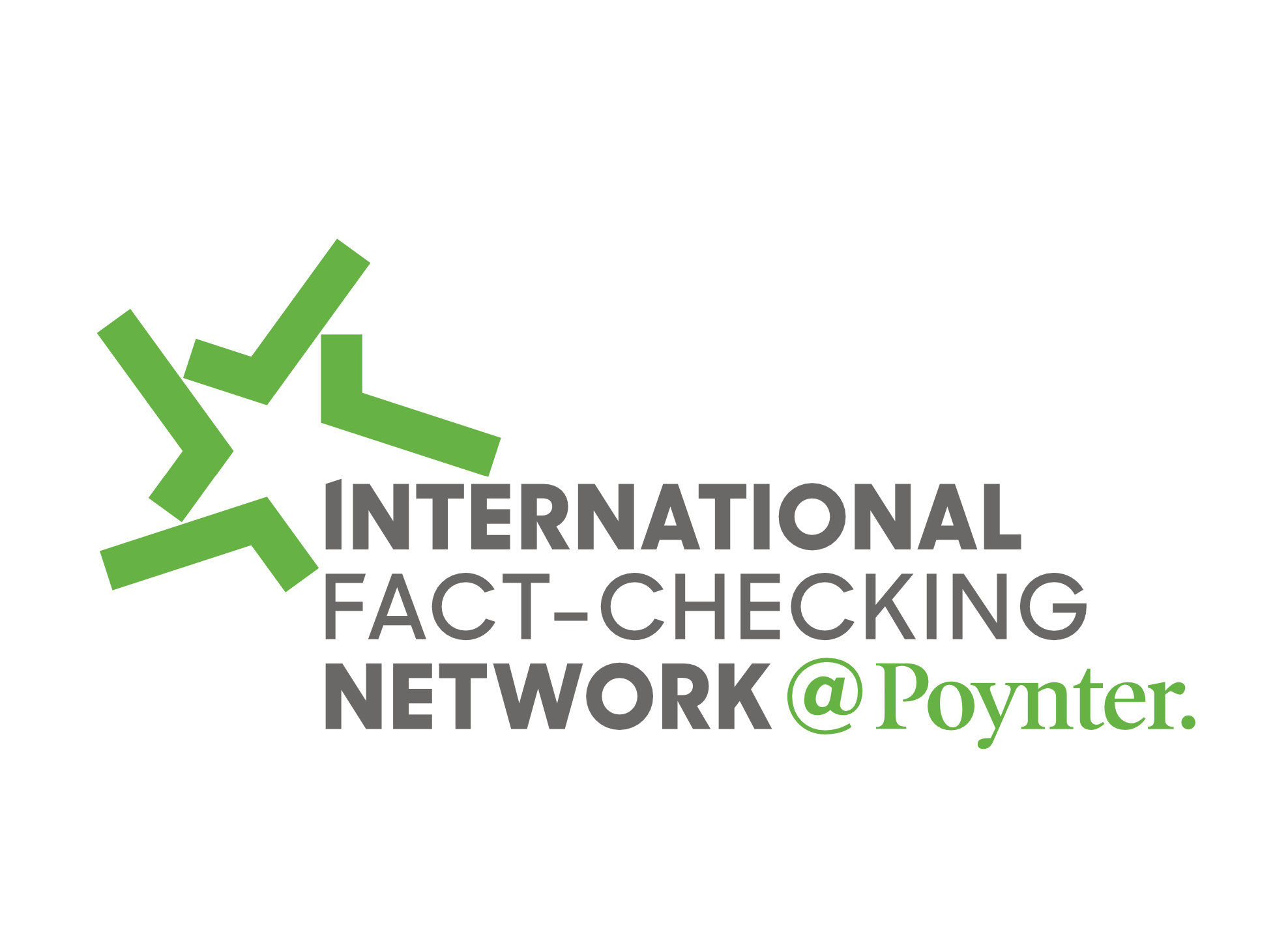 Covering COVID-19 is a daily Poynter briefing of story ideas about the coronavirus and other timely topics for journalists, written by senior faculty Al Tompkins. Sign up here to have it delivered to your inbox every weekday morning.
Covering COVID-19 is a daily Poynter briefing of story ideas about the coronavirus and other timely topics for journalists, written by senior faculty Al Tompkins. Sign up here to have it delivered to your inbox every weekday morning.
A new Paycheck Protection Program launches this week. Lenders who specialize in working with minority-owned small businesses got rolling yesterday, and tomorrow the program opens to borrowers who participated last year.
The 5,000 or so “community lenders” got a jump on everybody else because, in the first PPP, there were complaints that some of the businesses who needed the most help got left out. The biggest banks — including Bank of America, JPMorgan Chase, Cross River Bank and Wells Fargo — were the biggest lenders in the first round, and all of them will be lenders again this time, too.
The 2020 PPP included $523 billion that went to more than 5 million borrowers, big and small. The 2021 version will be $284 billion.
The PPP loans are, in reality, more like grants for most borrowers, who loans are forgiven if they use the money to avoid laying off workers.
During the first round, businesses with fewer than 500 employees could receive as much as $10 million. Big companies with healthy finances felt the public wrath when they grabbed some of the PPP pie. This time, the IRS will audit any borrower who gets $2 million or more in PPP loans. And this time, PPP borrowers must have fewer than 300 employees and must have experienced a 25% or more reduction in revenue in 2020 compared to 2019, not including loans that were forgiven in the last year.
Some critics say that requirement might loan money to businesses that are most likely to fail. The same critics also say the new PPP might be overcompensating restaurants. A Bloomberg columnist said, “The new round of the PPP allows restaurants to receive loans equal to 3.5 times their average monthly payroll costs, while businesses in other industries are restricted to loans of 2.5 times payroll expenses. Restaurants have been hurting, of course. But if consumers are going to want to eat out less in the post-virus economy, the government shouldn’t attempt to interfere by giving restaurants special treatment.”
Some nonprofit groups called 501(c)(6) organizations (which includes chambers of commerce) may apply for PPP loans this time around. Here is a list of requirements for borrowers who did not participate in the first PPP (go to page 13 of that document). There is another list of requirements for so-called “second-draw” applicants (flip to page 5 and 6 of that document).
The program rolling out this week is a little different than the first in how the money can be used. Last time, it was supposed to go to worker pay. But this time, employers can also use it for other operational expenses. Kiplinger explains:
Borrowers may spend up to 40% on other qualified expenses during the covered period. In addition to rent, mortgage interest and utilities, the list of eligible non-payroll expenses has been expanded to include four new categories:
- Covered operations expenditures;
- Covered property damage costs;
- Covered supplier costs; and
- Covered worker protection expenditures.
Covered operations expenditures include payments for any software, cloud computing, and other human resources or accounting needs.
The first PPP ran out of money within weeks. The U.S. Small Business Administration says this time, it thinks there will be plenty of money for all who qualify.
The PPP may be more important than anybody anticipated based on the newest jobless figures, which showed 140,000 Americans lost jobs in December. Employment had been rising since April — not to pre-COVID levels, but we were making progress. The SBA estimates that the first round of PPP loans saved 50 million jobs. But still, some borrowers, especially in the tech industry, took the loans and still laid workers off.
It would be fairly easy for journalists to contact employers who took advantage of the first round of the program by looking at the SBA data, which is searchable by name, zip code and so on.
The SBA released the data in two rounds, first for borrowers who got more than $150,000 and then, after media organizations sued, for borrowers of $150,000 and less.
[the_ad id=”667826″]
Two gorillas have been infected
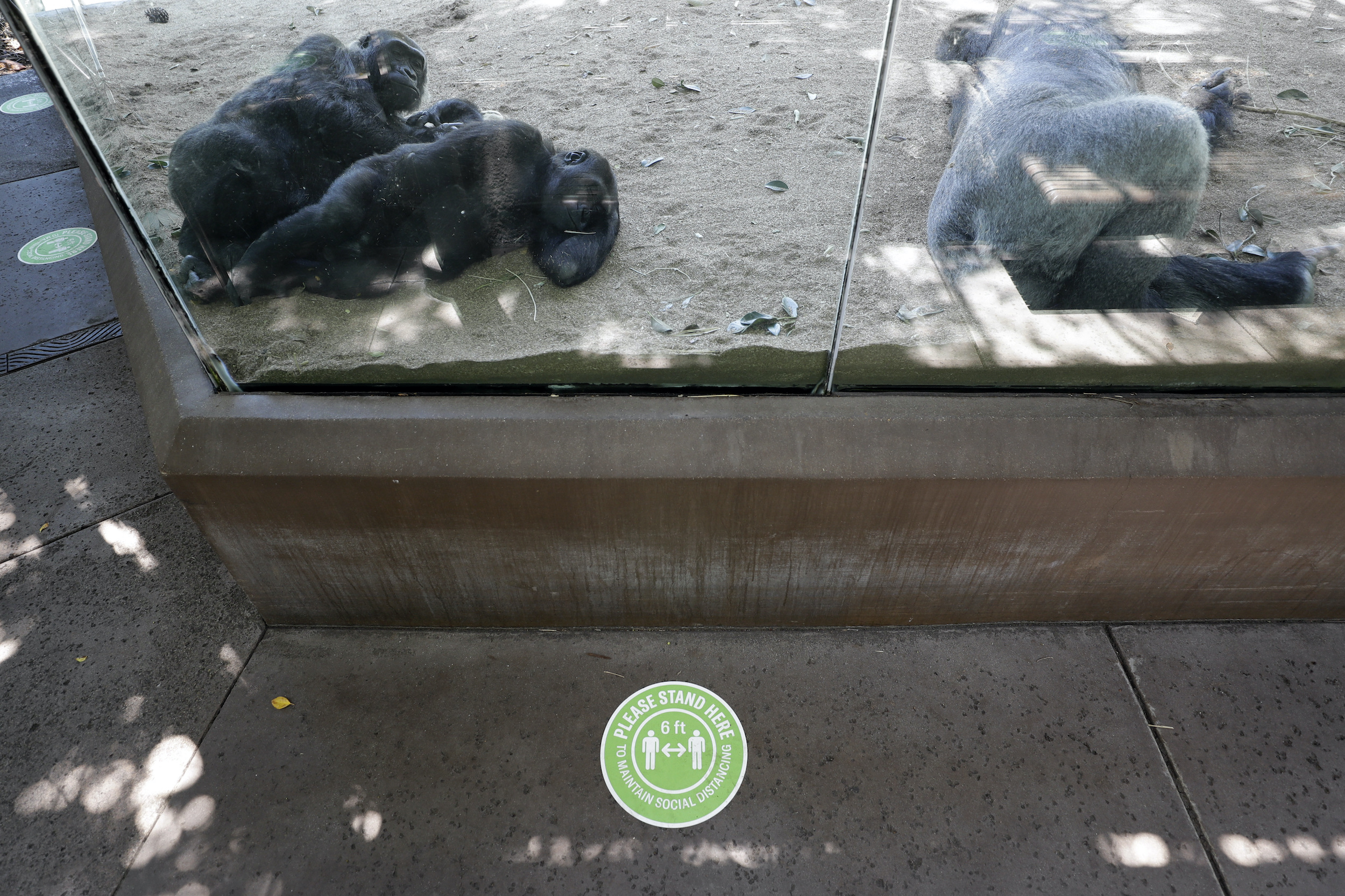
Gorillas rest in their enclosure at the San Diego Zoo, Thursday, June 11, 2020. (AP Photo/Gregory Bull)
At least two gorillas have tested positive for the coronavirus at the San Diego zoo. It is the first known such cases among such primates. The gorillas are doing fairly well, zookeepers said. It is not the first time that a human-to-zoo-animal infection has been documented. It was also noticed from humans to big cats in New York.
So far, the flu season has been lower than normal
Here is a little bit of good news, or maybe news that is not as bad as it might be. The Centers for Disease Control and Prevention says the seasonal flu is milder than normal. On the chart below, look at the little triangles at the bottom of the graph. They represent the 2020-2021 flu season.
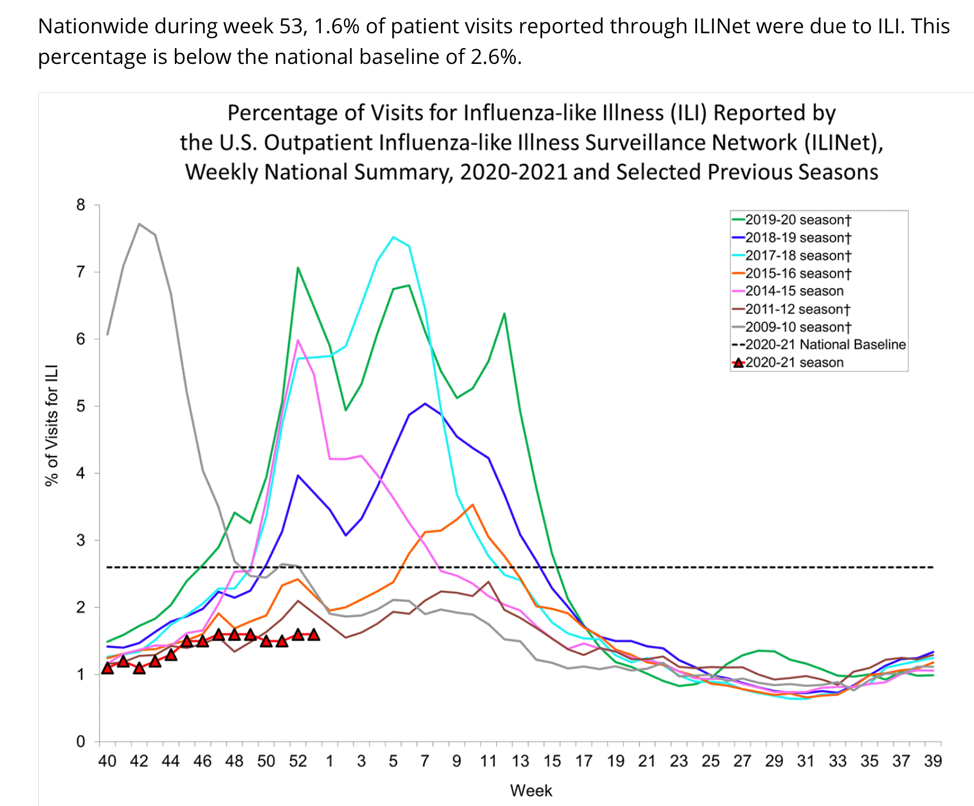
(CDC)
You can clearly see the traditional peak of the flu season is ahead of us, but so far, so good.
Georgia, Oklahoma and Nevada have moderate flu rates so far, but the rest of the country is mostly pretty low.
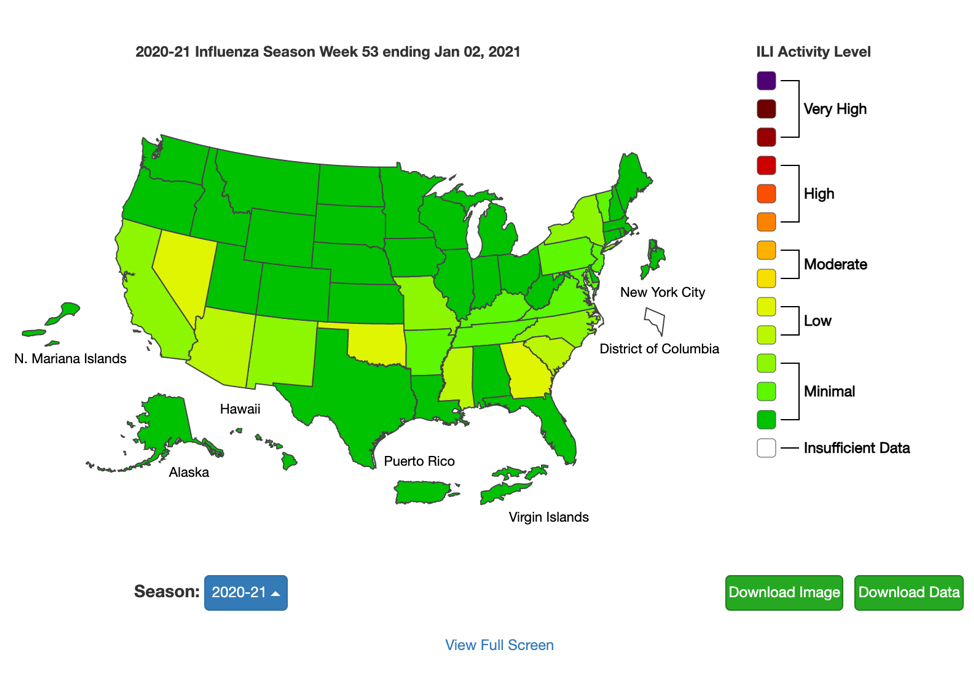
(CDC)
Not to be a pessimist, but once the post-holiday data starts rolling in, the CDC expects cases will rise.
As COVID-19 long-haulers know, death is not the only thing to be concerned about
New data published in The Lancet looks at 1,733 patients, the majority of whom have had lingering effects from COVID-19 including insomnia and diminished lung function. A fourth of these “long-haulers” have also, understandably, developed depression and anxiety.
Researchers still are mystified by some of these symptoms since most of these long-haulers test negative for the virus. One of the key questions is whether the symptoms are permanent. Researchers at UC Davis in California write:
The answer to this is not clear. Health care providers don’t know how many of these symptoms are permanent, or if there is permanent damage being done. Some patients who have been seriously ill from COVID-19 develop acute respiratory distress syndrome (ARDS), which can permanently scar their lungs. But it’s not clear if there is any scarring for long-haulers who have respiratory issues but not at the severe level of ARDS.
Other patients with long-term loss of smell and taste worry about permanent damage, too. Experts believe that the loss of smell and taste won’t be permanent. For most people, there will likely be resolution, but there isn’t a clear answer as to how long this will take.
How COVID-19 is connected to traffic tickets and the money they generate
The Miami Herald is tracking how when we drive less in a pandemic, cops write fewer tickets. When they write fewer tickets, courts generate less money from fines and fees. That affects local governments and even charities that depend on the money.
The Herald says:
In 2019, police agencies in Miami-Dade County filed 693,624 traffic citations. Last year, through the first 11 months of the year, it was just 361,718 citations, records show.
In Florida, the state thinks courts will collect more than $60 million less this year compared to the last budget year. Court clerks are financed by such fees in Florida.
Then there are groups like Epilepsy Florida, which gets $5 for every seatbelt infraction, and Mothers Against Drunk Drivers, which gets $50 from the fines that drunk drivers have to pay. Fewer tickets and arrests and more compliant drivers have cut their flow of funding.
Of course, all of this may just show the clear hazards of using fines as a direct revenue producer for essential services. Critics rightly point out that such budgeting rewards unforgiving and opportunistic enforcement of traffic laws.
COVID-19 causes a sperm bank shortage
This is a story you didn’t expect to see, and it is interesting. The New York Times says the pandemic has caused a drop in sperm donors but an increase in demand.
But now, the coronavirus pandemic is creating a shortage, sperm banks and fertility clinics said. Men have stopped going in as much to donate, even as demand has stayed steady at some banks and increased rapidly at others.
“We’ve been breaking records for sales since June worldwide not just in the U.S. — we’ve broken our records for England, Australia and Canada,” said Angelo Allard, the compliance supervisor of Seattle Sperm Bank, one of the country’s biggest sperm banks. He said his company was selling 20 percent more sperm now than a year earlier, even as supplies dwindled.
“Between our three locations, I’ll usually have 180 unique donors donating,” Mr. Allard said. “I’m down to 117. The other month it was 80. I don’t have any indication it’s going to be a positive trend.”
The pandemic has caused more interest in having children because parents are starting to see that it might be possible to spend more time working at home.
[the_ad id=”667872″]
2021 brings hospital billing transparency. Will you pay less?
A new regulation just kicked in that requires hospitals to be a lot more forthcoming about what they charge for hundreds of services and procedures. President Donald Trump can legitimately claim credit for pushing regulations that require hospitals to disclose the prices they negotiated with insurers and what cash-paying patients can expect to pay.
And the trend will continue next year for health insurers, who will also have to disclose their info. Drug companies, however, still do not have to list their prices, something the president also said he wanted.
With the new hospital rule, consumers should be able to see the tremendous variation in prices for the exact same care among hospitals and get an estimate of what they will be charged for care — before they seek it.
The new data requirements go well beyond the previous rule of requiring hospitals to post their “chargemasters” — the hospital-generated list prices that bear little relation to what it costs a hospital to provide care. Also, few consumers or insurers actually pay those listed prices.
You are going to see the prices of 70 common hospital services. And, Kaiser explains, there is more:
In addition, each hospital must also post, in a “consumer-friendly format,” the specific costs for 300 common and “shoppable” services, such as having a baby, getting a joint replacement, having a hernia repaired or undergoing a diagnostic brain scan.
Those 300 bundles of procedures and services must total all costs involved — from the hardware used to the operating room time, to drugs given and the fees of hospital-employed physicians — so patients won’t have to attempt the nearly impossible job of figuring it out themselves.
Will all of this make health care more affordable? It might if the disclosures lead to hospitals cutting better deals with everyone once special pricing is disclosed. But really, how many people shop for hospital costs? If you paid out of pocket, you might. But most people do not pay out of pocket.
The FBI says armed protests may be heading to your state capitol
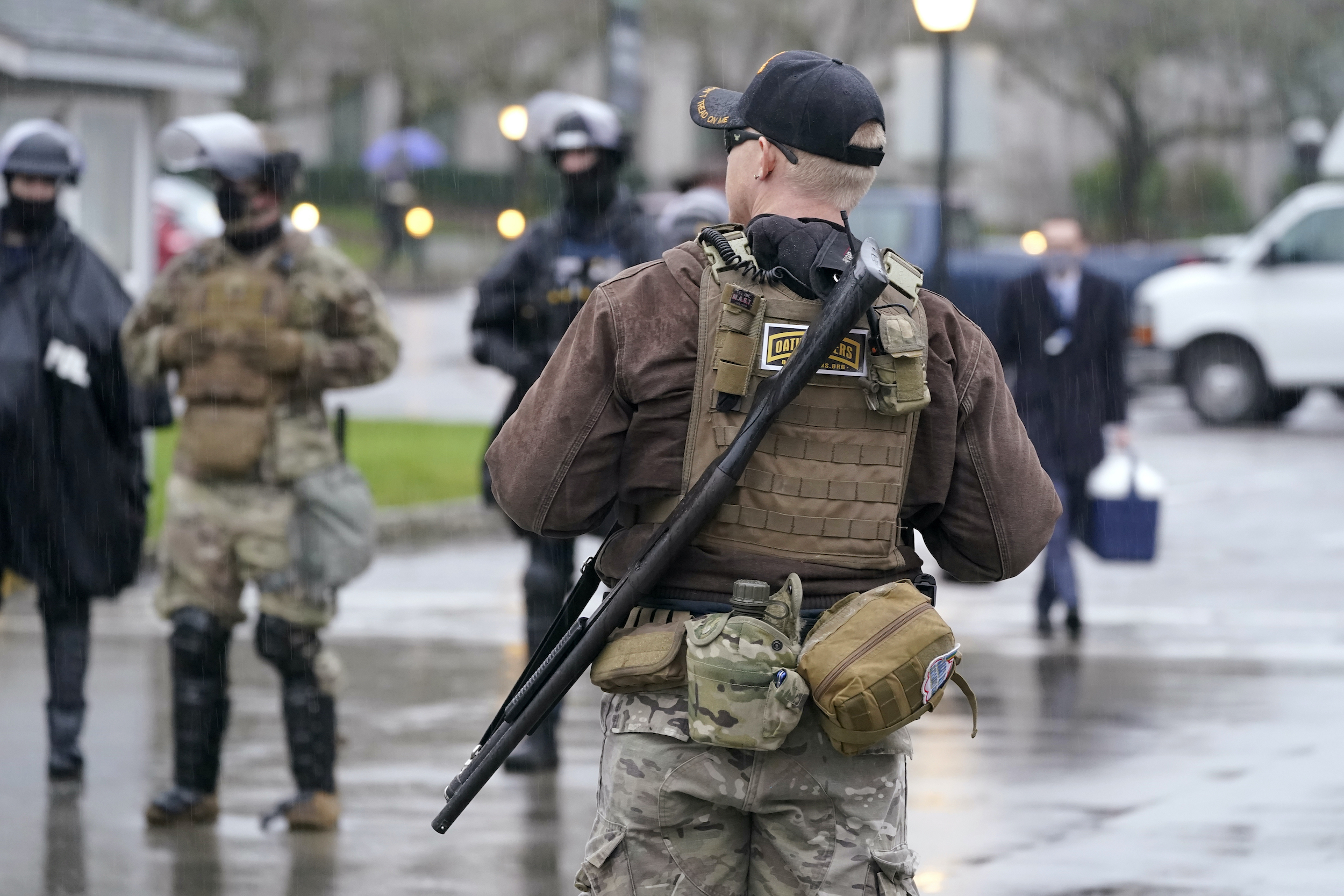
An armed protester stands outside the Capitol Monday, Jan. 11, 2021, in Olympia, Wash. (AP Photo/Ted S. Warren)
The Associated Press reports that an FBI bulletin is warning that every state capitol may see armed protesters arrive later this week and last through the inauguration next week. The FBI warning draws on intel from the Bureau of Alcohol, Tobacco, Firearms and Explosives; the Drug Enforcement Administration; the Department of Defense; Park Police; and the U.S. Marshals.
“Armed protests are being planned at all 50 state capitols from 16 January through at least 20 January, and at the U.S. Capitol from 17 January through 20 January,” the bulletin said, according to one official. The officials were not authorized to speak publicly and spoke to the AP on condition of anonymity.
The FBI issued at least one other bulletin — they go out to law enforcement nationwide on the topic — before the riots last week. On Dec. 29, it warned of the potential for armed demonstrators targeting legislatures, the second official said.
The FBI memo, called a “situational information report,” was produced by the FBI’s Minneapolis field office and, according to Yahoo News, “It addresses concerns about rallies that the far-right boogaloo movement plans to hold in cities across the country on Jan. 17.”
The senior law enforcement official says the FBI’s National Crisis Coordination Center distributed the update to law enforcement agencies as a summary of threat information they’ve received following last Wednesday’s deadly mob attack on the Capitol.
While the memo discusses possible threats discussed by online actors for Jan. 16 through the inauguration of President-elect Joe Biden on Jan. 20, it doesn’t mean that law enforcement agencies expect violent mass protests or confrontations in every state.
Meanwhile, about 6,000 guardsmen from six states already are in the capital, said Army Gen. Daniel R. Hokanson, the chief of the National Guard Bureau. By this weekend, the number could expand to 10,000.
Bellingcat has an enlightening investigation into the trail that led Ashli Babbitt to the U.S. Capitol, where she was shot and killed as she climbed through a window broken by her fellow rioters.
[the_ad id=”667878″]
The times in which we live
You may have missed this on Monday. The new Mississippi flag replaces the one that included the Confederate battle flag. Voters approved the new design.
New flag featuring a white Magnolia flower and the words “In God We Trust” now flies high over the Mississippi State Capitol @WJTV pic.twitter.com/51h9zCPzki
— Thao Ta (@ThaoTaTV) January 11, 2021
We’ll be back tomorrow with a new edition of Covering COVID-19. Sign up here to get it delivered right to your inbox.






